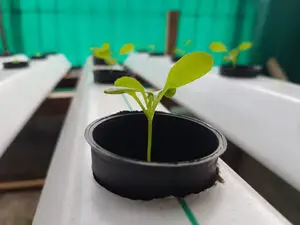Contents
There’s no doubting that a hydroponic garden is becoming increasingly popular because to its convenience, efficiency, and environmental friendliness as compared to traditional gardening. But where do you start if you want to join this current hydroponic gardening trend?
One of the most crucial considerations you’ll have to make is which growth system to choose for your hydroponic garden. Your decision will be influenced by your budget, the plants you wish to grow, and your level of gardening knowledge.
 Basic Wick Hydroponics
Basic Wick Hydroponics
This simple, low-cost setup is ideal for beginners who want to get their feet wet in hydroponics. The simple wick system is easy to construct and is ideal for tiny plants such as herbs. A rope or “wick” connects a container housing your plants to a container holding fresh water and nutrients. The fibers in the wick carry nutrients from the water to the healthy plants. This technique is great for fresh herbs, a small indoor garden and those with not enough outdoor space.
Deep Water Culture
Deep water culture is another user-friendly system. A submersible pump is used to deliver oxygen to the nutrient solution in this arrangement. Hydroponic plants are suspended over nutrient-rich water, held in place by Styrofoam or plastic. The deep water system is ideal for lettuce and other types of greens, and it is ideal for tiny spaces. Teachers frequently utilize this technique to introduce hydroponics to their pupils in the classroom.
Drip Hydroponics
The drip system, which is quite popular among commercial and home growers, is scalable, which means it can fit larger plants than the basic wick and deep water culture systems. Drip systems are ideal for the growing of plants like melons, zucchini, onions, and cucumbers. The supply of water is recirculated and fertilizers are continuously supplied to the mature plants, thanks to a water pump and timer.
Ebb and Flow Hydroponics
Ebb and flow hydroponic systems flood the hydroponic vegetables with extra nutrients, then slowly drain the nutrient solution back into a water reservoir for reuse. This technique is good for plants that have limited tolerance for gallons of water and require periods of dryness to aid root growth. A variety of plants like strawberries, tomatoes, beans, spinach, and carrots can thrive in this system. To suit their growing needs, growers might put up simple or elaborate ebb and flow systems. Ebb and flow need consistent monitoring, particularly of environmental parameters such as water pH.
Nutrient Film Technique (NFT)
The NFT technology is well-known for assisting garden plants in achieving rapid plant growth rates. Growers also like how this technique allows them to produce types of plants in fewer locations. An NFT system is simple to maintain and conserves both oxygenated water solution and hydroponic nutrients. It doesn’t utilize any growing medium, which saves money. Plant roots that are suspended in a tray with plant root systems dangling in a hydroponic solution obtain more oxygen. Cucumbers, spinach, tomatoes, peppers, and herbs may grow when given adequate space and assistance!
Aeroponic System
An aeroponic system, like the nutrient film approach, has no growing medium. Hydroponic crops are suspended from growing ports and given nutrient-rich solution mists as needed. Hydroponic nutrients can be applied either automatically or manually by growers. Aeroponic systems can be basic or complex depending on the demands of the grower. Because of the increased oxygen levels, tomatoes, eggplant, melons, herbs, lettuces, squash, and edible flowers thrive. Larger systems installed indoors in areas without windows or sufficient light, on the other hand, will require app-controlled grow lights.
Your hydroponic farm will always produce fresh, healthy, and delicious produce, free of dirt, pests, and diseases. You won’t get your hands dirty, therefore it’s also a less untidy manner of gardening. It’s time to take the first step if we’ve persuaded you of the power and benefits of hydroponics.

